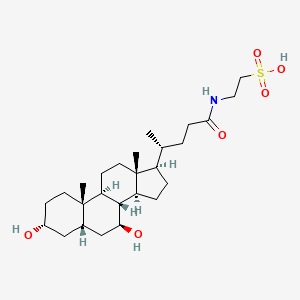| MeSH term | MeSH ID | Detail |
|---|---|---|
| Hypertension | D006973 | 115 associated lipids |
| Insulin Resistance | D007333 | 99 associated lipids |
Tauroursodeoxycholic acid
Tauroursodeoxycholic acid is a lipid of Sterol Lipids (ST) class. Tauroursodeoxycholic acid is associated with abnormalities such as Hyperglycemia, Obesity, Wiskott-Aldrich Syndrome, neurogenic hypertension and Cholestatic liver disease. The involved functions are known as Cell Death, Apoptosis, Homeostasis, Process and mRNA Expression. Tauroursodeoxycholic acid often locates in Body tissue, Endoplasmic Reticulum, Hepatic, Blood and Protoplasm. The associated genes with Tauroursodeoxycholic acid are Homologous Gene and Mutant Proteins. The related lipids are cholanic acid, taurolithocholic acid 3-sulfate, Sterols, 7-dehydrocholesterol and tauromuricholic acid. The related experimental models are Disease model.
Cross Reference
Introduction
To understand associated biological information of Tauroursodeoxycholic acid, we collected biological information of abnormalities, associated pathways, cellular/molecular locations, biological functions, related genes/proteins, lipids and common seen animal/experimental models with organized paragraphs from literatures.
What diseases are associated with Tauroursodeoxycholic acid?
Tauroursodeoxycholic acid is suspected in Endothelial dysfunction, Hyperglycemia, Obesity, neurogenic hypertension, Cholestatic liver disease, Heart failure and other diseases in descending order of the highest number of associated sentences.
Related references are mostly published in these journals:
| Disease | Cross reference | Weighted score | Related literature |
|---|
Possible diseases from mapped MeSH terms on references
We collected disease MeSH terms mapped to the references associated with Tauroursodeoxycholic acid
PubChem Associated disorders and diseases
What pathways are associated with Tauroursodeoxycholic acid
There are no associated biomedical information in the current reference collection.
PubChem Biomolecular Interactions and Pathways
Link to PubChem Biomolecular Interactions and PathwaysWhat cellular locations are associated with Tauroursodeoxycholic acid?
Visualization in cellular structure
Associated locations are in red color. Not associated locations are in black.
Related references are published most in these journals:
| Location | Cross reference | Weighted score | Related literatures |
|---|
What functions are associated with Tauroursodeoxycholic acid?
Related references are published most in these journals:
| Function | Cross reference | Weighted score | Related literatures |
|---|
What lipids are associated with Tauroursodeoxycholic acid?
Related references are published most in these journals:
| Lipid concept | Cross reference | Weighted score | Related literatures |
|---|
What genes are associated with Tauroursodeoxycholic acid?
Related references are published most in these journals:
| Gene | Cross reference | Weighted score | Related literatures |
|---|
What common seen animal models are associated with Tauroursodeoxycholic acid?
Disease model
Disease model are used in the study 'Bile Acids Reduce Prion Conversion, Reduce Neuronal Loss, and Prolong Male Survival in Models of Prion Disease.' (Cortez LM et al., 2015).
Related references are published most in these journals:
| Model | Cross reference | Weighted score | Related literatures |
|---|
NCBI Entrez Crosslinks
All references with Tauroursodeoxycholic acid
Download all related citations| Authors | Title | Published | Journal | PubMed Link |
|---|---|---|---|---|
| Liu Y et al. | Quercetin induces protective autophagy and apoptosis through ER stress via the p-STAT3/Bcl-2 axis in ovarian cancer. | 2017 | Apoptosis | pmid:28188387 |
| Fernández-Sánchez L et al. | Controlled delivery of tauroursodeoxycholic acid from biodegradable microspheres slows retinal degeneration and vision loss in P23H rats. | 2017 | PLoS ONE | pmid:28542454 |
| Rani S et al. | Tauroursodeoxycholic acid (TUDCA) attenuates pressure overload-induced cardiac remodeling by reducing endoplasmic reticulum stress. | 2017 | PLoS ONE | pmid:28426781 |
| Paridaens A et al. | Modulation of the Unfolded Protein Response by Tauroursodeoxycholic Acid Counteracts Apoptotic Cell Death and Fibrosis in a Mouse Model for Secondary Biliary Liver Fibrosis. | 2017 | Int J Mol Sci | pmid:28117681 |
| Xie C et al. | An Intestinal Farnesoid X Receptor-Ceramide Signaling Axis Modulates Hepatic Gluconeogenesis in Mice. | 2017 | Diabetes | pmid:28223344 |
| Cheang WS et al. | PPARδ Is Required for Exercise to Attenuate Endoplasmic Reticulum Stress and Endothelial Dysfunction in Diabetic Mice. | 2017 | Diabetes | pmid:27856609 |
| Guo Q et al. | Fibroblast growth factor 21 reverses suppression of adiponectin expression via inhibiting endoplasmic reticulum stress in adipose tissue of obese mice. | 2017 | Exp. Biol. Med. (Maywood) | pmid:27811171 |
| Contreras C et al. | Reduction of Hypothalamic Endoplasmic Reticulum Stress Activates Browning of White Fat and Ameliorates Obesity. | 2017 | Diabetes | pmid:27634226 |
| Zhang J et al. | Baicalin protects AML-12 cells from lipotoxicity via the suppression of ER stress and TXNIP/NLRP3 inflammasome activation. | 2017 | Chem. Biol. Interact. | pmid:29031535 |
| Guo H et al. | Endoplasmic Reticulum Chaperon Tauroursodeoxycholic Acid Attenuates Aldosterone-Infused Renal Injury. | 2016 | Mediators Inflamm. | pmid:27721575 |
